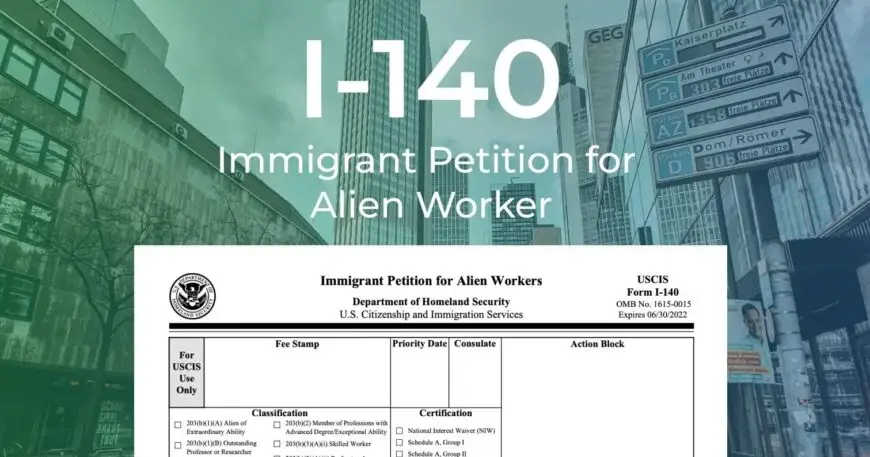Immigration for employment-based purposes can be the most difficult area of U.S. immigration law and policy to navigate through. At Syed Professional Services, we make an effort to streamline these complex procedures for our clients. I-140 Immigrant Petition: The Key Ingredient In This Process In this blog post, we will cover what I-140 is and how it works, along with its processing times and status check, providing you with in-depth insight.
What is the I-140?
An I-140, or Immigrant Petition for Alien Worker, is a form submitted to the United States Citizenship and Immigration Services (USCIS) by an employer on behalf of their worker. It is really important petition made for foreign national only who want to get. migration stopped for permanent resident category based on work The I-140 falls under the second and third preference employment-based immigration categories, including professionals with advanced degrees, skilled workers, and unskilled worker.
Key Points About the I-140:
To be eligible to file for an I-140, employer must have a job offer with role that meets certain criteria Second, to pay the wage that will be offered.
Supporting Evidence: The petition must be supported by evidence that the foreign worker meets all requirements for the position. This could be the credentials of your education, job experience letters, and evidence of any licenses (legal, etc.) or certifications.
Responsibility of Employer: The employer will have to show their financial stability by paying the salary of employee. This is usually demonstrated through tax returns, annual reports, or audited financial statements.
I-140 Processing Time
One of the most frequently asked questions about the I-140 is regarding its processing time. The processing time for the I-140 petition can vary based on several factors, including the service center handling the case, the category of employment, and whether the employer opts for premium processing.
Standard Processing: Typically, the processing time for an I-140 petition under standard processing can range from six months to over a year. This timeline can be affected by the service center’s caseload and the complexity of the individual petition.
Premium Processing: For employers who require expedited processing, USCIS offers a premium processing service for an additional fee. This service guarantees a decision on the petition within 15 calendar days. However, not all I-140 categories are eligible for premium processing.
Factors Affecting I-140 Processing Times
Several elements can influence the processing time of an I-140 petition, including:
Service Center Workload: The volume of petitions at the specific USCIS service center handling the application.
Employment Category: Certain employment categories may have different processing times due to their complexity and demand.
Request for Evidence (RFE): If USCIS requires additional information, they will issue an RFE, which can significantly delay the processing time.
Priority Date: The priority date, which is based on when the labor certification or I-140 petition was filed, can also impact processing times.
Checking Your I-140 Status
Once the I-140 petition is filed,. Both the employer and the beneficiary (a foreign worker) will want to stay updated on the petition’s status. Here are the steps to check the status of your I-140 petition:
Receipt Notice: After filing the I-140 petition, the employer will receive a Receipt Notice from USCIS. This notice contains a unique receipt number, which can be used to track the status of the petition.
Online Status Check: Visit the USCIS website and enter the receipt number in the “Check Your Case Status” tool. This will provide the most current status of your I-140 petition.
USCIS Contact Center: If you are unable to check the status online or need more detailed information, you can contact the USCIS Contact Center. Be prepared to provide the receipt number and other relevant details about the petition.
Notifications: Employers and beneficiaries can sign up for email and text message notifications from USCIS to receive updates on the petition’s status.
Common I-140 Statuses
There are certain statuses, one of which you will find when checking the status of your I-140 petition.
Received: USCIS has received the petition and it is in line waiting to be processed
Case Was Approved: USCIS has approved the petition.
Rejected: The petition has been reviewed and rejected. The denial notice will state the reasons for the denial, how you can appeal, and what steps to take in order to refile.
Receives Request for Evidence (RFE):USCIS needs more information or cannot make a decision without additional documentation.
The term NOID, which stands for Notice of Intent to Deny, is explained in the Title. Typically, USCIS sends notices that begin with the words “We intend to deny your application unless you provide additional evidence.”
Conclusion
Filing an I-140 petition is a critical step in the employment-based immigration process. Understanding the details of what the I-140 entails. The processing times and how to check their status can help both employers and foreign workers navigate this complex process with more confidence.
At Syed Professional Services,
Our specialty is assisting businesses and employees with the immigration process. ensuring that all paperwork, including forms, is filled out accurately and sent in. Do not hesitate to get in touch with us if you need help or have any questions about your I-140 petition.
Please visit our website or contact our knowledgeable team of immigration professionals for more details and individualized help. We are available to assist you at every stage.




